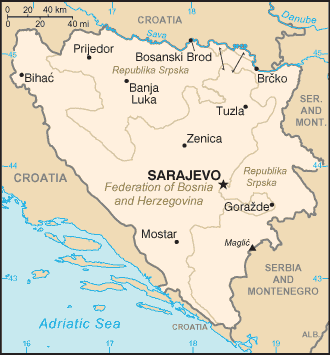Bosnia


Bosnia and Herzegovina's declaration of sovereignty in October 1991, was followed by a declaration of independence from the former Yugoslavia on 3 March 1992 after a referendum boycotted by ethnic Serbs. The Bosnian Serbs - supported by neighboring Serbia and Montenegro - responded with armed resistance aimed at partitioning the republic along ethnic lines and joining Serb-held areas to form a "greater Serbia." In March 1994, Bosniaks and Croats reduced the number of warring factions from three to two by signing an agreement creating a joint Bosniak/Croat Federation of Bosnia and Herzegovina. On 21 November 1995, in Dayton, Ohio, the warring parties initialed a peace agreement that brought to a halt three years of interethnic civil strife (the final agreement was signed in Paris on 14 December 1995). The Dayton Agreement retained Bosnia and Herzegovina's international boundaries and created a joint multi-ethnic and democratic government. This national government was charged with conducting foreign, economic, and fiscal policy. Also recognized was a second tier of government comprised of two entities roughly equal in size: the Bosniak/Croat Federation of Bosnia and Herzegovina and the Bosnian Serb-led Republika Srpska (RS). The Federation and RS governments were charged with overseeing internal functions. In 1995-96, a NATO-led international peacekeeping force (IFOR) of 60,000 troops served in Bosnia to implement and monitor the military aspects of the agreement. IFOR was succeeded by a smaller, NATO-led Stabilization Force (SFOR) whose mission is to deter renewed hostilities. SFOR remains in place although troop levels were reduced to approximately 12,000 by the close of 2002.
Geography
Southeastern Europe, bordering the Adriatic Sea and Croatia
Within Bosnia and Herzegovina's recognized borders, the country is divided into a joint Bosniak/Croat Federation (about 51% of the territory) and the Bosnian Serb-led Republika Srpska or RS (about 49% of the territory); the region called Herzegovina is contiguous to Croatia and Serbia and Montenegro (Montenegro), and traditionally has been settled by an ethnic Croat majority in the west and an ethnic Serb majority in the east
Government
Government type:emerging federal democratic republic
Capital:Sarajevo
Administrative divisions:there are two first-order administrative divisions and one internationally supervised district* - Brcko district (Brcko Distrikt)*, the Bosniak/Croat Federation of Bosnia and Herzegovina (Federacija Bosna i Hercegovina) and the Bosnian Serb-led Republika Srpska; note - Brcko district is in northeastern Bosnia and is an administrative unit under the sovereignty of Bosnia and Herzegovina; the district remains under international supervision
Independence:1 March 1992 (from Yugoslavia; referendum for independence was completed 1 March 1992; independence was declared 3 March 1992)
Constitution:the Dayton Agreement, signed 14 December 1995, included a new constitution now in force; note - each of the entities also has its own constitution
Diplomatic representation in the US:
chief of mission: Ambassador Igor DAVIDOVIC
chancery: 2109 E Street NW, Washington, DC 20037
telephone: [1] (202) 337-1500
consulate(s) general: New York
FAX: [1] (202) 337-1502
Diplomatic representation from the US
chief of mission: Ambassador Clifford G. BOND
embassy: Alipasina 43, 71000 Sarajevo
mailing address: use street address
telephone: [387] (33) 445-700
FAX: [387] (33) 659-722
branch office(s): Banja Luka, Mostar
Government - note:The Dayton Agreement, signed in Paris on 14 December 1995, retained Bosnia and Herzegovina's exterior border and created a joint multi-ethnic and democratic government. This national government - based on proportional representation similar to that which existed in the former socialist regime - is charged with conducting foreign, economic, and fiscal policy. The Dayton Agreement also recognized a second tier of government, comprised of two entities - a joint Bosniak/Croat Federation of Bosnia and Herzegovina and the Bosnian Serb Republika Srpska (RS) - each presiding over roughly one-half the territory. The Federation and RS governments are charged with overseeing internal functions. The Bosniak/Croat Federation is further divided into 10 cantons. The Dayton Agreement established the Office of the High Representative (OHR) to oversee the implementation of the civilian aspects of the agreement.
Economy
Bosnia and Herzegovina ranked next to The Former Yugoslav Republic of Macedonia as the poorest republic in the old Yugoslav federation. Although agriculture is almost all in private hands, farms are small and inefficient, and the republic traditionally is a net importer of food. Industry has been greatly overstaffed, one reflection of the socialist economic structure of Yugoslavia. TITO had pushed the development of military industries in the republic with the result that Bosnia hosted a number of Yugoslavia's defense plants. The bitter interethnic warfare in Bosnia caused production to plummet by 80% from 1990 to 1995, unemployment to soar, and human misery to multiply. With an uneasy peace in place, output recovered in 1996-99 at high percentage rates from a low base; but output growth slowed in 2000-02. GDP remains far below the 1990 level. Economic data are of limited use because, although both entities issue figures, national-level statistics are limited. Moreover, official data do not capture the large share of black market activity. The marka - the national currency introduced in 1998 - is now pegged to the euro, and the Central Bank of Bosnia and Herzegovina has dramatically increased its reserve holdings. Implementation of privatization, however, has been slow, and local entities only reluctantly support national-level institutions. Banking reform accelerated in 2001 as all the Communist-era payments bureaus were shut down. The country receives substantial amounts of reconstruction assistance and humanitarian aid from the international community but will have to prepare for an era of declining assistance.
Industries:steel, coal, iron ore, lead, zinc, manganese, bauxite, vehicle assembly, textiles, tobacco products, wooden furniture, tank and aircraft assembly, domestic appliances, oil refining (2001)






























